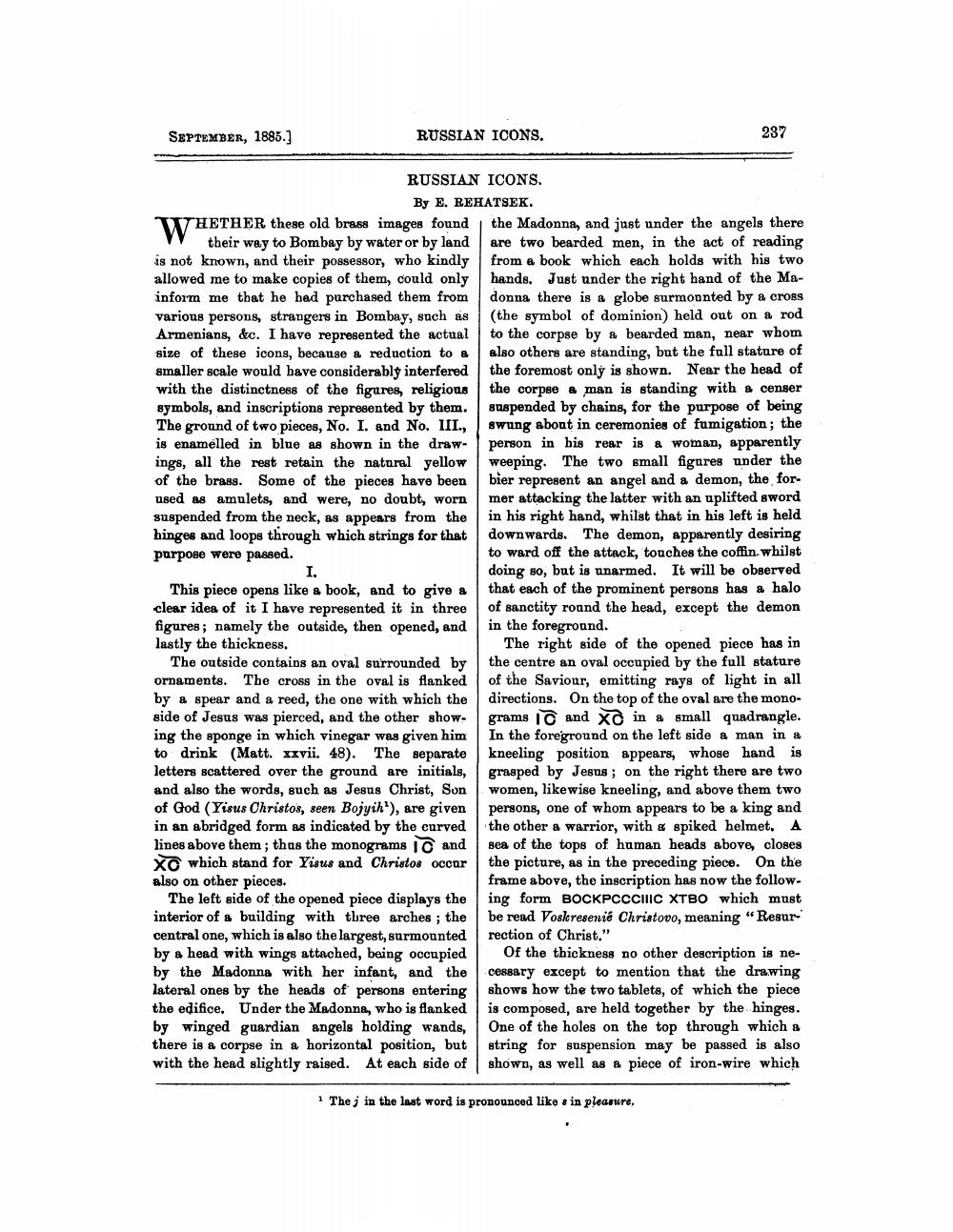________________
SEPTEMBER, 1885.]
RUSSIAN ICONS.
RUSSIAN ICONS. By E. REHATSEK.
WH WHETHER these old brass images found their way to Bombay by water or by land is not known, and their possessor, who kindly allowed me to make copies of them, could only inform me that he had purchased them from various persons, strangers in Bombay, such as Armenians, &c. I have represented the actual size of these icons, because a reduction to a smaller scale would have considerably interfered with the distinctness of the figures, religious symbols, and inscriptions represented by them. The ground of two pieces, No. I. and No. III., is enamelled in blue as shown in the draw
ings, all the rest retain the natural yellow of the brass. Some of the pieces have been used as amulets, and were, no doubt, worn suspended from the neck, as appears from the hinges and loops through which strings for that purpose were passed.
I.
This piece opens like a book, and to give a clear idea of it I have represented it in three figures; namely the outside, then opened, and lastly the thickness.
The outside contains an oval surrounded by ornaments. The cross in the oval is flanked by a spear and a reed, the one with which the side of Jesus was pierced, and the other showing the sponge in which vinegar was given him to drink (Matt. xxvii. 48). The separate letters scattered over the ground are initials, and also the words, such as Jesus Christ, Son of God (Yisus Christos, seen Bojyih'), are given in an abridged form as indicated by the curved lines above them; thus the monograms 10 and XO which stand for Yisus and Christos occur also on other pieces.
The left side of the opened piece displays the interior of a building with three arches; the central one, which is also the largest, surmounted by a head with wings attached, being occupied by the Madonna with her infant, and the lateral ones by the heads of persons entering the edifice. Under the Madonna, who is flanked by winged guardian angels holding wands, there is a corpse in a horizontal position, but with the head slightly raised. At each side of
237
the Madonna, and just under the angels there are two bearded men, in the act of reading from a book which each holds with his two hands. Just under the right hand of the Madonna there is a globe surmounted by a cross (the symbol of dominion) held out on a rod to the corpse by a bearded man, near whom also others are standing, but the full stature of the foremost only is shown. Near the head of the corpse a man is standing with a censer suspended by chains, for the purpose of being swung about in ceremonies of fumigation; the person in his rear is a woman, apparently weeping. The two small figures under the bier represent an angel and a demon, the former attacking the latter with an uplifted sword in his right hand, whilst that in his left is held downwards. The demon, apparently desiring to ward off the attack, touches the coffin. whilst doing so, but is unarmed. It will be observed that each of the prominent persons has a halo of sanctity round the head, except the demon in the foreground.
The right side of the opened piece has in the centre an oval occupied by the full stature of the Saviour, emitting rays of light in all directions. On the top of the oval are the monograms C and XO in a small quadrangle. In the foreground on the left side a man in a kneeling position appears, whose hand is grasped by Jesus; on the right there are two women, likewise kneeling, and above them two persons, one of whom appears to be a king and the other a warrior, with a spiked helmet. A sea of the tops of human heads above, closes the picture, as in the preceding piece. On the frame above, the inscription has now the following form BOCKPCCCIIIC XTBO which must be read Voskresenie Christovo, meaning "Resurrection of Christ."
Of the thickness no other description is necessary except to mention that the drawing shows how the two tablets, of which the piece is composed, are held together by the hinges. One of the holes on the top through which a string for suspension may be passed is also shown, as well as a piece of iron-wire which
1 The j in the last word is pronounced like s in pleasure.




